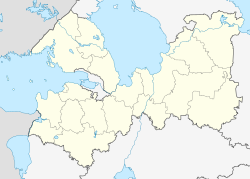Novoye Devyatkino
| Village
Novoye
Devyatkino Новое Девяткино
|
||||||||||||||||||||||||||||||||||||||
|
||||||||||||||||||||||||||||||||||||||
|
||||||||||||||||||||||||||||||||||||||
| List of large settlements in Russia | ||||||||||||||||||||||||||||||||||||||
Novoje Dewjatkino ( Russian Но́вое Девя́ткино ) is a village (derewnja) in Leningrad Oblast in Russia with 10,978 inhabitants (as of October 14, 2010).
geography
The place is a good 15 km as the crow flies northeast of the center of the Oblast capital Saint Petersburg , just under 3 km outside the city limits, not far from the left bank of the right Neva tributary Ochta .
Novoye Devyatkino belongs to the Vsevolozhsky Rajon and is located a good 10 km west-northwest of its administrative center, Vsevolozhsk . The village is the seat and only locality of the rural community Novodevyatkinskoje selskoje posselenije.
history
A village called Dewjatkino, also Dewjatkina, about 3 km north of today's location was first mentioned in the first half of the 18th century. In the middle of the 19th century, the area was described as being predominantly inhabited by Ingrian Finns , and the village was alternatively known as Miina in Finnish . In connection with the establishment of an artillery - training area from 1863 parts of the village were moved to its present location 1887/1888 and were given the name of Novo-Dewjatkino ( "New Dewjatkino", Finnish Uusi Miina ). During the Second World War , the Finnish population of the village was deported to Siberia in 1942.
Novoje Devyatkino remained an insignificant village until the Turboatomgas plant north of the place was built for turbines and other power plant equipment in 1977 and the place was expanded with prefabricated buildings from the mid-1980s . But he always retained the status of a village and was in the census of 2010, the second largest town in Russia with the usual mostly for smaller villages Status Derevnya after Watutinki in the Moscow Oblast , the but with the incorporation to Moscow in 2012 as part of the community (posselenije) Dessjonowskoje lost its independence. Novoye Devyatkino was subordinate to the village Soviet Murino from the 1930s until it became the seat of an independent rural community on January 1, 2006.
Population development
| year | Residents |
|---|---|
| 1905 | 130 |
| 1926 | 223 |
| 1939 | 471 |
| 2002 | 8,847 |
| 2010 | 10,978 |
Note: census data
traffic
Novoje Devyatkino is located on the regional road 41K-065, which leads from the St. Petersburg ring road (A118) via Toksowo to Matoksa , where it meets the 41A-189 (formerly A128), the "Northern Half-Ring" around St. Petersburg.
In the southwestern neighboring village of Murino, closer to the Saint Petersburg city limits, there is the Dewjatkino railway station on the Saint Petersburg - Priosersk - Chijtola (- Sortavala ; route kilometer 12 from Kuschelewka; kilometer 17 from Saint Petersburg Finnish line, which opened in 1917 and has been electrified on this section since 1958 Train station from where there is suburban train service ). The northern terminus of the same name on the Kirovsko-Vyborgskaya line of the Saint Petersburg metro , opened on December 29, 1978 as Komsomolskaya and renamed on July 1, 1992, is located near the station.
Web links
- Official website of the local government (Russian)
Individual evidence
- ↑ a b Itogi Vserossijskoj perepisi naselenija 2010 goda. Tom 1. Čislennostʹ i razmeščenie naselenija (Results of the All-Russian Census 2010. Volume 1. Number and distribution of the population). Tables 5 , pp. 12-209; 11 , pp. 312–979 (download from the website of the Federal Service for State Statistics of the Russian Federation)




